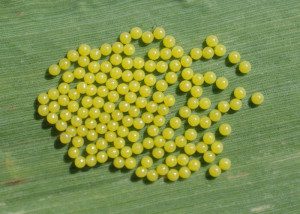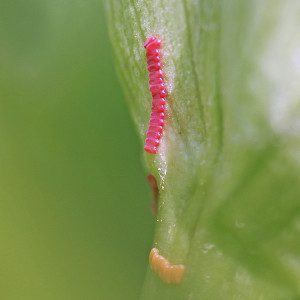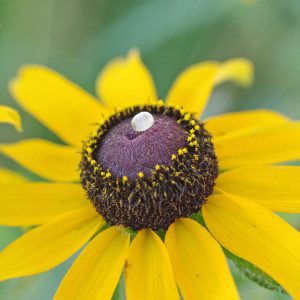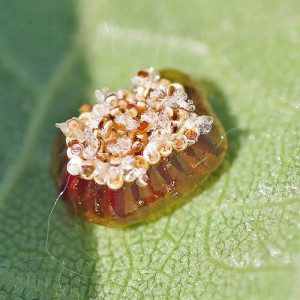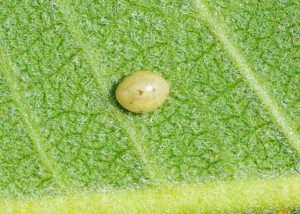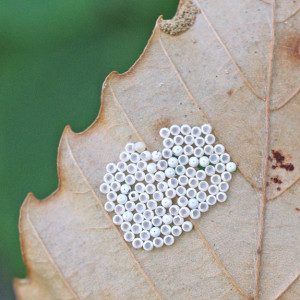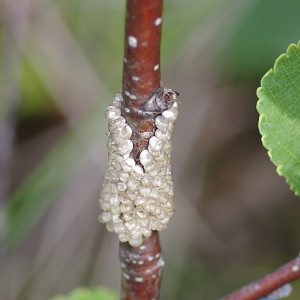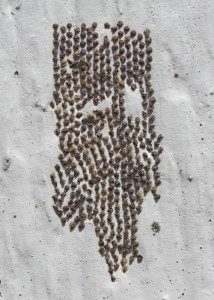Greetings, BugFans,
Most insects begin their lives inside an egg that’s been deposited near/onto/into the correct food source, in the correct habitat for the eventual young. The BugLady often photographs these eggs, but she didn’t know much about them. Here are some Selected Short Subjects about insect eggs (and the BugLady apologizes in advance, she couldn’t help herself).
- Insect eggs come in all sizes and shapes and colors (and some change colors between the time they are deposited and the time they hatch). For some eggsquisite pictures, see http://www.atlasobscura.com/articles/the-blobby-dazzling-world-of-insect-eggs (ignore the text, which has a major eggsample of a “publish-in-haste-and-repent-at-leisure” boo-boo). Some eggs are laid alone, some in clusters, and some en masse, enclosed in a webby or gelatinous protective case. In some species, females detect pheromones left by recent, egg-laying females that tell them “This space is taken.”
- Insect eggs are pretty small. How small are they? The Book of Insect Records tells us that, at 0.027mm by 0.02mm, the tiniest insect egg belongs to a tachinid fly (an egg parasite that oviposits within the egg of another insect): http://entnemdept.ifas.ufl.edu/walker/ufbir/chapters/chapter_07.shtml. The website comes from the University of Florida, which publishes lots of good insect information on-line http://entnemdept.ifas.ufl.edu/walker/ufbir/chapters/index_order.shtml. Here’s another egg parasite at work – https://blogs.scientificamerican.com/compound-eye/use-this-simple-photographic-trick-to-make-tiny-insect-eggs-look-enormous/. And yes, there are egg parasites that victimize other egg parasites – an entomological matryoshka doll. For a long time it was believed that insects with complete metamorphosis (egg-larva-pupa-adult) laid smaller eggs and had smaller young because they were more “unfinished” when they hatched than did insects with incomplete metamorphosis (egg-nymph-adult), but that’s not eggactly true.
- Like an onion, an insect egg is layered, the layers manufactured within the female’s reproductive system via a process called oogenesis. In general, the outer layer/egg shell/chorion is made of lipo-proteins, sometimes covered with a waxy coat. The chorion may be sticky initially, so it will adhere to the surface it’s placed on. There are several layers between the chorion and the inner layer, which is called the cell wall or vitelline membrane and which wraps the nucleus and yolk. The surface of the shell has one or more tiny openings called micropyles, usually located on the top of the egg, and it may be minutely textured.
- The egg that is manufactured within the female contains at its core an unfertilized female gamete/germ cell. Fertilization happens when sperm find their way through one of the micropyles/micropylar canals after the egg shell is formed around the nucleus. After fertilization, division of cells in the nucleus will result in an insect embryo that eats the yolk particles.
- Seems like a lot of fuss – what’s the advantage of this system? Only that developing a weatherproof egg allowed insect ancestors to emerge from life in the sea about 400 million years ago, that’s all (although aquatic insects still lay their eggs in water – more about that in a sec). An inner membrane called the serosa restricts water flow through the egg shell; holding inside the moisture that Mom put there so her little bug wouldn’t desiccate, and keeping eggscess water outside. This has allowed insects to eggspand into almost all environments. Silverfish and a few groups of flies don’t have a serosa, but they lay their eggs in moist habitats, and their embryos develop really fast.
- Too much of a good thing? Turns out that the qualities that allow the egg shell to protect the developing bug from drying out and from getting squished and (with varying success) from predation are not quite so good for oxygen eggschange. The answer – more “pyles” or pores. Though some air can be absorbed through the shell itself, the main ingress area(s) is/are other pore(s) called aeropyles. (older references say that the micropyle also allows oxygen to enter; others differentiate and use the term “aeropyle” for pores involved in gas exchange). The number and arrangement of these pores depends on the species.
- Insect eggs face big swings in air temperature, and although embryos have higher metabolisms at higher temperatures (needing more oxygen), the rate of diffusion of oxygen through the chorion doesn’t necessarily keep up. This can result in low oxygen concentrations (hypoxia) within the egg (one source said that the hatching of common green darner eggs is triggered by hypoxia). In the recent BOTW about millipedes, the BugLady mentioned that arthropods were bigger 400 million years ago, when temperatures were cooler and atmospheric oxygen concentrations were higher. Information about the interseggtion of temperature, metabolism, and oxygen diffusion through the chorion suggests that arthropod eggs may also have been super-sized.
- How about aquatic insects that still lay their eggs under water? Blogger Dragonfly Woman, an eggspert on giant water bugs in the family Belostomatidae, tells us that “Many aquatic insect eggs don’t have aeropyles at all and depend on oxygen flowing directly through the shell.” She continues “[Abedus herberti eggs] have a structure called a plastron network. Plastron networks are meshworks made up of many tiny projections of the chorion. This meshwork is thought to trap air against eggs when they are underwater so that they don’t drown. Many terrestrial eggs have these plastron networks and this structure may allow them to survive accidental submersion for some time. Water bugs also usually have plastron networks that may be responsible for their survival while they are underwater. Lots of other aquatic insects that lay their eggs in water don’t have these structures at all.” Read her full eggsplaination at https://thedragonflywoman.com/2011/02/07/the-anatomy-of-insect-eggs/. Amazing pictures.
- How long does it take for an egg to hatch? Anywhere from a few days to months. Many months, in the case of insects that overwinter in the egg stage.
- Eggs, it seems, don’t move, so they’re sitting ducks for predators. Like their parents, many eggs are chemically protected against egg grazers and egg parasites. The operative chemicals may be manufactured by Mom, or she may sequester them from plants that she eats (or both) before incorporating them into the shell. Though direct paternal care of eggs is rare in insects, males of some species gift the female with toxic chemicals during courtship, and these are built into the egg. Her eggs may have a toxic shell, be decorated with toxic hairs, be disguised with camouflage colors or brilliant with aposematic colors, or be unpalatable because of a layer of eggscrement. In the “Very Cool” department, a female (herbivorous) stinkbug dots the outside surface of each of egg with feces that contain bacteria needed by her offspring to digest plant materials. The newly-hatched bugs hang around the egg mass for a while, ingesting the bacteria.
- Honeybees are the only insects that incubate their eggs and young (by using body heat to keep the temperature in the nursery between 92 and 97 degrees) (they flap their wings like crazy). Other insects are at the mercy of the temperature of air or water around them. Warmer surroundings = faster hatching.
- What do the plants think of all this? Most than you’d eggspect. The BugLady recalls the days when living things were divided firmly into two Kingdoms, Plant and Animal (eggcept for some pesky flagellated, unicellular, chlorophyll-bearing organisms lurking uneasily in between). Plants were defined as organisms that didn’t move and didn’t have a sensory system and that produced their own food. More and more studies show that plants not only receive signals, but they also communicate with other plants chemically (great Ray Bradbury short story about a man who designs a machine that lets him hear plants). Research shows that plants recognize, react to, and communicate with plants downwind about grazing by caterpillars like gypsy moths, and that tomato plants are aware of oviposition by a moth and mobilize defensive proteins in their leaves before the caterpillars even hatch.
Write researchers Kim Jimwon et al, “Thus far, plants appear to recognize at least three events as indicators of future herbivory. First, some plants increase resistance against insects when a neighboring plant suffers insect herbivory. In this case, plants appear to “eavesdrop” on volatile organic compounds released by the neighboring plant under herbivory and elicit their defenses. Moreover, the volatile-receiving plants showed priming of defenses, meaning the receiver plants activated faster or stronger defenses upon the anticipated herbivory. Second, insect footsteps can induce defensive responses in plants…. Third, oviposition, one of the most common events preceding insect larval herbivory, can induce a variety of direct and indirect defenses of plants.”http://journals.plos.org/plosone/article?id=10.1371/journal.pone.0037420. For more about plant “senses”, see https://www.pri.org/stories/2014-01-09/new-research-plant-intelligence-may-forever-change-how-you-think-about-plants. And, of course, in the eggscalating chemical battle, a few insects can secrete chemicals that moderate the plant’s anti-herbivore tactics. The BugLady’s head may eggsplode.
After last week’s episode on Common green darners, BugFan Linda, whose eggstraordinary videos of pond life were featured in a January BOTW, responded that she had posted this video just a few days before https://www.youtube.com/watch?v=SgsEMAKUeX8. AWESOME, Linda, thanks!
Kate Redmond, The BugLady
Bug of the Week archives:
http://uwm.edu/field-station/

